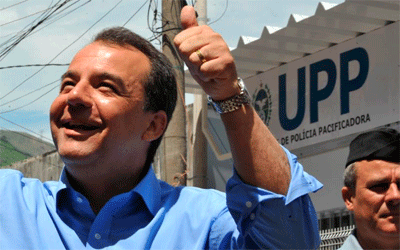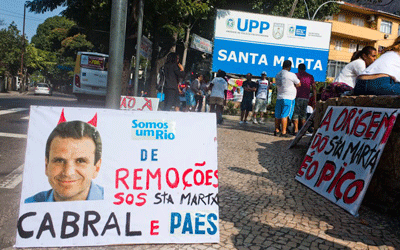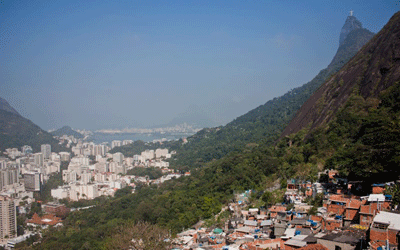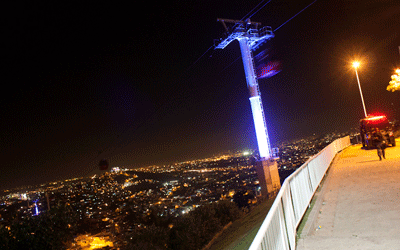Pacifying Police Units (UPPs) guarantee free access to capital in Rio’s impoverished communities. For original article in Portuguese in Brasil de Fato click here.

The current politics of military intervention implemented through the UPPs (Pacifying Police Units) in Rio’s favelas has brought about a new scenario in the city’s impoverished communities. The enforcement of these police forces and the entry of commercial capital in such spaces have generated tensions in the favelas, of which real estate speculation is one of the main examples. Rental prices and the costs of services and goods have forced many old residents to leave neighborhoods. This is what we call ‘white removals.’ The general increase in the cost of living in the favelas generates the expulsion of residents without even having to use tractors or a gun.
The military intervention is legitimized by a civil war discourse, parallel power and regions besieged by drug traffickers and/or militiamen. This propaganda, which has been repeated over the years by government and the media, has spread throughout the city and has almost become a consensus. In Rio de Janeiro, more than 20% of the city’s inhabitants live in favelas. This means nearly 1.3 million people in 763 communities, which move R$13 billion per year. This amount is higher than the Gross Domestic Product (GDP) of many Brazilian capital cities, such as Florianópolis, Natal and Cuiabá.
“With the accommodation of the UPPs in the favelas, capital can now settle in those regions with some level of legal and patrimonial security, which has not always been the case.” This is the opinion of Rodrigo Castelo, professor at the Federal University of the State of Rio de Janeiro (Unirio).
The market climbs the hill

This has been happening on a massive scale since the installation of the first UPPs. The market has been keeping an eye on the purchasing potential of residents in these localities. “The economic power of the favelas is strong,” argues Romualdo Ayres, sustainability director of the Brazilian Association for Franchising. All the Brazilian franchises together will earn approximately R$14 billion in 2012. Meanwhile, the favela’s GDP is R$13 billion. “The incomeavailable to all these people is comparable to that of all Brazilian franchises put together. There is an economic food chain left by the absence of the drug traffic that needs to be replaced,” Ayres asserts.
Stories about successful enterprises stimulate investors further, even before the implementation of the UPPs took place. This is also the case for the language school Yes, in Rocinha. The branch on the hill has 750 students enrolled, well above the 550 average enrollments in other branches in town. These kinds of investments are very safe, and have a low default rate.
The massive entry of enterprises into the favelas reflects the interest of capital that is actually behind the discourse of public security. “This process taking place in Rio’s popular communities clearly demonstrates the interests of capital being actively supported by the State,” Rodrigo Castelo asserts. He recalls that until recently, favelas were perceived as repositories for cheap labor for the central regions in Rio, and, at the same time, as “dens of criminality.”
The new look by capital towards the favelas

The market’s change in positioning, supported by the State, occurs as soon as the favelas begin to be perceived as very profitable spaces. “That is when large chains of cinemas, supermarkets, and banks settle in,” says Castelo. According to the professor, the entry of these enterprises can generate an increase in employment and income, but at the same time it can also bring impoverishment. “It will generate employment and income in the favelas. There is no way we can doubt this reality: but will these jobs and incomes be sufficient to cover the increase in expenses that people who live there will experience?” he asks himself.
The professor reckons that at first, this movement will generate wealth, which might be followed by the impoverishment of many residents. “What will occur is what, in fact, has already occurred in some localities: people will not have the financial capacity to stay in that space,” he evaluates.
In November, the Mayor of Rio announced that he will refer to the City Council a project to reform the property tax (IPTU). Residents of areas that are considered to be at risk are exempt from taxes. Only 40% of documented residential real estate currently pays the tax. With the proposed changes, this percentage should increase to 97%. Who will be able to afford this?
Real estate speculation invades the favelas

According to Rio’s Housing Syndicate (Secovi/RJ), Rio de Janeiro recently obtained at least one more inflationary component: the creation of the UPPs installed by the State’s Secretary of Public Security. From 2008 onwards the secretary has implemented 31 UPPs. Since then in some favelas real estate has increased in value by 100% or more.
In addition to the cost of real estate, the cost of living has increased due to the regularization of electricity and water services, without special programs for low-income people. The residents unable to pay for these services will only have the option to sell their property and move to a remote area of the city without adequate public services. This is what is being called “white removal” (gentrification). Without (needing to) use the word removal, the State would be fostering the exit of age-old residents from areas which are now highly valued. The middle class will then occupy the hills with a divine view over the “Marvellous City.”
The UPPs have two legs: the militarization and the commodification of the favelas. Nowadays, the cable car in Morro do Alemão receives more tourists than the Sugarloaf cable car, traditionally a touristic highlight of Rio. This past November the Alemão cars received more than double the visitors of Sugarloaf.
Commercial press and government unite
The state government is counting on the press, which has been playing an important role in the spatial reorganization of the favela, as a valuable ally in the implantation of this project. According to Castelo, nowadays in Brazil, an ideology is been created to justify this kind of intervention. In this way, “the process of acceptance will become easier, also for the residents that will suffer the most terrible processes.” Romualdo Ayres fills in: “Months ago, when I received the news that Rede Globo’s soap opera would portray Complexo do Alemão, I thought: “That place will get hot.”
What the interested public should be discussing is what a project would look like that serves the interests of the people, the city’s workers, rather than the interests of big contractors and real estate speculators. “For this social movements must participate in discussions and organize themselves to apply pressure to have their interests addressed,” Castelo asserts.
